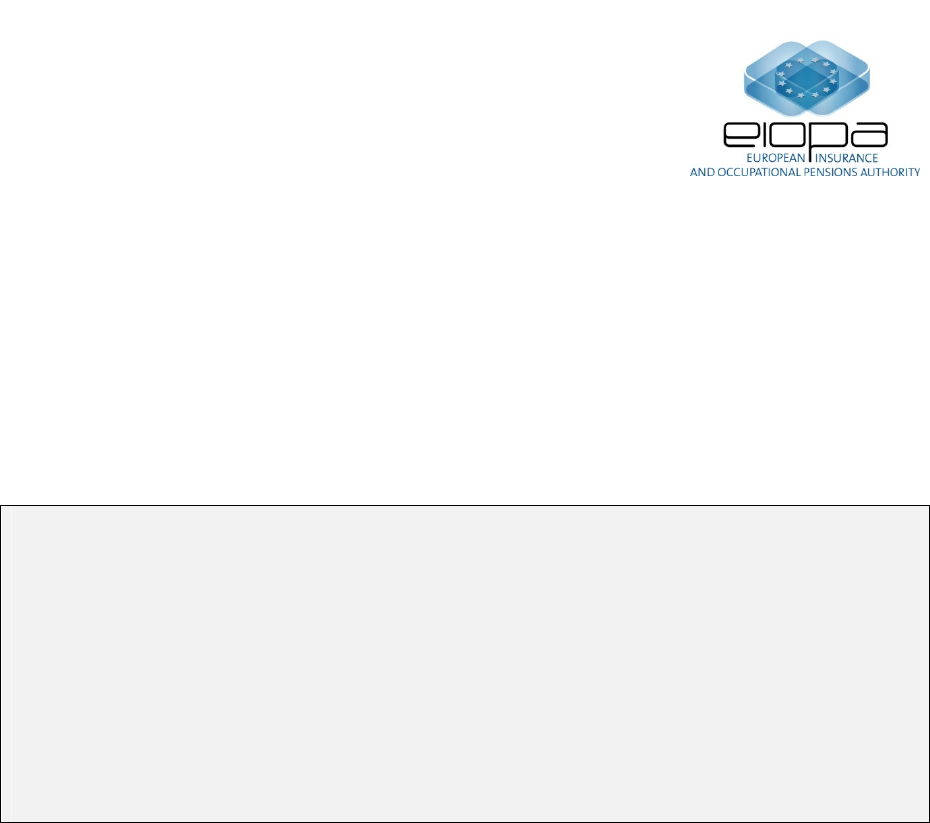
1/4
© EIOPA 2012
EIOPABoS12/070
14 June 2012
Report on Best Practices by Insurance
Undertakings in handling complaints

2/4
© EIOPA 2012
Introduction
The following Report contains a list of best practices for handling complaints by
insurance undertakings. Their purpose is to contribute to “enhancing customer
protection” as described in the underlying statutory objectives of EIOPA
1
. They
are based on Article 29(2), EIOPA Regulation
2
whereby EIOPA may “develop new
practical instruments and convergence tools to promote common supervisory
approaches and practices”.
They provide examples of best practices and are complementary to the
“Guidelines on ComplaintsHandling by Insurance Undertakings” (EIOPABoS
12/069).
These Best Practices are not legally binding on competent authorities or financial
institutions as defined under Regulation 1094/2010 establishing EIOPA (“the
EIOPA Regulation”) and are not subject to the “comply or explain” mechanism
provided for under Article 16 of the EIOPA Regulation as their legal basis is
Article 29(2).
1
Article 1(6)(f), EIOPA Regulation
2
„ The Authority ([EIOPA] may, as appropriate, develop new practical instruments and convergence tools to
promote common supervisory approaches and practices”.
3/4
© EIOPA 2012
Having regard to the “Guidelines on ComplaintsHandling by Insurance
Undertakings” (EIOPABoS12/069), on internal systems and controls:
Content of a “complaints management policy”
It is considered best practice for an insurance undertaking’s “complaints
management policy” to include processes for:
(i) Lodging a complaint with an insurance undertaking by any reasonable
means (including complaints submitted by an authorised representative
e.g. a family member or a solicitor) and confirmation that this is free of
charge;
(ii) Handling complaints received, including deadlines etc.
(iii) The fair treatment of complainants;
(iv) The proper treatment of a complainant’s information and personal data,
according to the applicable legal framework;
(v) Preventing, identifying and managing possible situations of conflicts of
interest in complaints management;
(vi) The prompt, equal, fair and efficient management of complaints,
(vii) The adequate training of staff participating in complaintshandling within
the insurance undertaking;
(viii) Internal reporting, followup and monitoring of compliance with the
“complaints management policy”.
Organisation of the internal complaints management function
Irrespective of the specific model that insurance undertakings have adopted for
complaints handling, it is considered best practice for insurance undertakings
to:
(i) Appoint one or more senior manager(s) with overall regulatory
responsibility for the complaints management function;
(ii) Ensure the necessary internal flows of information and reporting lines for
complaints management.
(iii) Control the effective and efficient treatment of complaints
4/4
© EIOPA 2012
Registration
Without prejudice to applicable EU/national legislation on record keeping/data
protection, it is considered best practice for:
(i) an insurance undertaking’s register of complaints to contain all the
necessary information on the complaints, including:
(i) Subject of the complaint;
(ii) Data on the complainant;
(iii) Date of receiving and answering the complaint;
(iv) Result/outcome of the complaintshandling procedure;
(iv) Class of the insurance referred to.
(ii) Documentation relating to the complaint to be kept and archived in a
secure manner for a reasonable period of time based on the nature of the
complaint and the insurance undertaking involved.
(iii) Insurance undertakings to provide information to complainants regarding
their complaint, where reasonably requested by complainants.
Reporting
The relevant supervisory authorities should be informed of any changes in the
identity and contact details of members of senior management involved in the
complaints management function as referred to above.
Internal followup of complaintshandling
It is considered best practice for an insurance undertaking to have in place the
following processes in order to comply with the proper internal followup of
complaints:
(i) The collection of management information on the causes of complaints and
the products and services complaints relate to;
(ii) A process to identify the root causes of complaints and to prioritise dealing
with the root causes of complaints;
(iii) A process to consider whether the root causes identified may affect other
processes or products;
(iv) A process for deciding whether root causes discovered should be corrected
and how this should be done; and
(v) Regular reporting to senior personnel where information on recurring or
systemic problems may be needed for them to play their part in identifying,
measuring, managing and controlling risks of regulatory concern and
keeping records of analysis and decisions taken by senior personnel in
response to management information on root causes of complaints.
